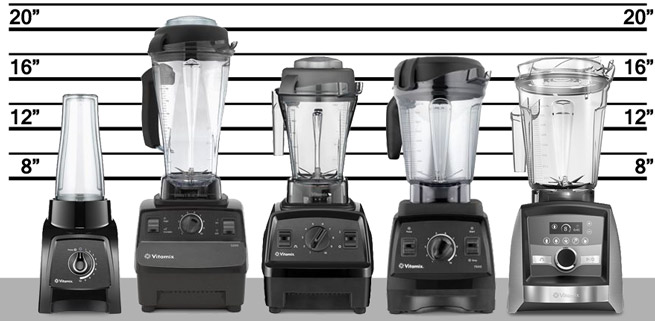 Last Updated November 13, 2023
Last Updated November 13, 2023
The most common Vitamix shopper’s question is some variant of, “I want to make smoothies, soups, and frozen desserts. Which Vitamix blender is best for me?” The answer is that all Vitamix machines work great for those tasks; which one is best depends on whether you want to pay for extra features.
If you don’t want to go through the nitty-gritty, here are my quick Vitamix recommendations:
Which is the best Vitamix model?
Best Value
- E310 (short/narrow container for small to medium amounts)
- Recon 5200 (tall/narrow container for small to large amounts)
- Recon A2500 (short/wide container for medium to large amounts)
Money Is No Object
A3500 (I highly recommend the elegant metal bases.)
The November 2023 Vitamix shopping landscape
Almost all models are on sale for the holidays! Shop the sale.
Vitamix recently launched the A3500 with 48-oz metal container option. I’ve been asking them to offer container choice for years, and this is the first step in that direction. This combination is awesome for anyone who wants a premium machine and prefers a narrow container.
The recent release of the Food Processor Attachment gives more reason to consider Ascent and Venturist models, since it is not compatible with classic models. If you don’t care about the premium finish of the A3500, consider saving big on the Reconditioned V1200 (recent price drop, not sure if it is permanent).
If you are looking for the lowest possible price, I recommend choosing between the Recon 5200, the E310, and the Recon A2500. The most significant difference between these models is the container they come with, so use the following Venn diagram to pick the optimal container for you. There are trade-offs between the three container options. To put it briefly, “short, narrow, or large capacity: pick 2”: 
Note that I am linking to the Recon A2500 as the value wide container pick because there is a special discount. Via links from this site, the price drops $100 after adding it to the shopping cart.
Note to visitors from outside the United States: The model availability described on this page is for the USA (and APO/FPO addresses). If you are shopping from Canada, check out my page about Canadian Vitamix models.
For most people, I recommend choosing from the following four categories: Certified Reconditioned models, Explorian, Premium Classic, and Ascent.
Reconditioned
 If you are looking for the lowest possible price on Vitamix, reconditioned is for you. Some people are hesitant to buy reconditioned, and that is a valid concern with some companies, but Vitamix’s reconditioned units are guaranteed to be top quality. The only reasons I would avoid reconditioned Vitamix are if it is for a gift for someone who won’t understand, or if you want some of the features not available on reconditioned machines.
If you are looking for the lowest possible price on Vitamix, reconditioned is for you. Some people are hesitant to buy reconditioned, and that is a valid concern with some companies, but Vitamix’s reconditioned units are guaranteed to be top quality. The only reasons I would avoid reconditioned Vitamix are if it is for a gift for someone who won’t understand, or if you want some of the features not available on reconditioned machines.
Explorian
 If you prefer a slightly smaller container, I highly recommend the new E310, which comes with a short and narrow 48-oz container (full review). The Explorian E320 is functionally identical to the E310, but it comes with a wide container. That makes it nearly identical to the 5300. (The E320 replaces the 5300 in the model lineup, and it is mostly the same, with a few changes: it does not have the on-off switch on the side, and it does not light up when on. I don’t think these differences matter much, but there they are for anyone wondering about E320 vs. 5300.)
If you prefer a slightly smaller container, I highly recommend the new E310, which comes with a short and narrow 48-oz container (full review). The Explorian E320 is functionally identical to the E310, but it comes with a wide container. That makes it nearly identical to the 5300. (The E320 replaces the 5300 in the model lineup, and it is mostly the same, with a few changes: it does not have the on-off switch on the side, and it does not light up when on. I don’t think these differences matter much, but there they are for anyone wondering about E320 vs. 5300.)
There is now also an Explorian E520, which comes with the wide 64-oz container and adds 3 preset blending modes. With the hidden discount that gets activated after clicking a Vitamix link on this site and then adding the Recon E520 to your shopping cart, it is an excellent deal.
Premium Classic and Propel
If you want the most premium machine, but don’t want the new technology of Ascent, then the Professional Series 750 is for you. I think the Ascent machines are quite nice, but you might not like the look of their digital display, or you might want to be able to use older containers (without NFC chips).
In 2023 Vitamix released a new Series, which they are calling the Propel. Similar to the Pro 750, these machines have preset modes and a secondary on-off switch. The Propel machines also have the subtly updated styling that was released with the Explorian series: Propel 510 and Propel 750.
Ascent (Smart System Blenders)
If you want to buy into the future of Vitamix, the Ascent Series is the way to go. It’s priced in the same range as new Legacy models, but it comes with various upgrades (among them: longer warranty, timer display, can use small cups without bulky adapter, and a wireless connection to smartphone app).

 Within the Ascent Series, the A2300 is the lowest-priced model and it has everything you need. (If you’re buying reconditioned, the A2500 is the lowest-priced model, and it has all the features of the A2300, including full variable speed control, and it adds 3 preset program modes.) If you feel like upgrading, I recommend going all the way up to the A3500, because it has premium finish options. (I’m not saying that the intermediate Ascent models are a bad choice, they just wouldn’t be my choice.) See my Ascent review page for more details.
Within the Ascent Series, the A2300 is the lowest-priced model and it has everything you need. (If you’re buying reconditioned, the A2500 is the lowest-priced model, and it has all the features of the A2300, including full variable speed control, and it adds 3 preset program modes.) If you feel like upgrading, I recommend going all the way up to the A3500, because it has premium finish options. (I’m not saying that the intermediate Ascent models are a bad choice, they just wouldn’t be my choice.) See my Ascent review page for more details.
If you’ve been putting off getting a Vitamix because you’re saving up, you can get one right away with a payment plan. If you make on-time payments, there are zero financing fees.
You can leave a comment below or contact me if you are still having trouble deciding which one to get.
Comparison of pre-Ascent models follows
If you want to quickly see the relation between all of the different Vitamix models, you can jump ahead to my comparison chart.
I made an interactive tool to help explore the different features. Try playing with it to get a sense of which you are interested in. You can click any model to go to its Vitamix.com page, or you can read more about the different models below.
+ Show model selection tool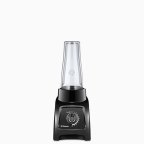 Recon S30
Recon S30 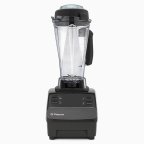 Recon 2-Speed
Recon 2-Speed  Recon 5200
Recon 5200  Recon 5300
Recon 5300  Recon Pro 500
Recon Pro 500 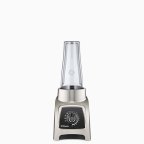 Recon S55
Recon S55  S30
S30  2-Speed
2-Speed  S50
S50  Recon 7500
Recon 7500  5200
5200  S55
S55 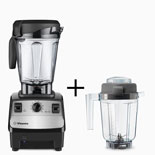 Recon 5300 + 32oz
Recon 5300 + 32oz  Recon Pro 750
Recon Pro 750  7500
7500  Pro 500
Pro 500  Recon 7500 + 32oz
Recon 7500 + 32oz  Pro 750
Pro 750 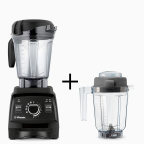 Recon Pro750+32oz
Recon Pro750+32oz  7500 + 32oz
7500 + 32oz  Pro 750 + 32oz
Pro 750 + 32oz  780
780 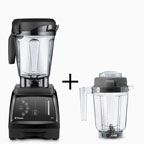 780 + 32oz
780 + 32oz(If you want the 32-oz container, you have to add it to your cart separately: 32-oz container link)
If you’re overwhelmed by the choices and just want to know my preference, I’ve used all of the different types of Vitamix blenders, and before I started using Ascent, the one I used on a daily basis was the 7500, with an extra 32-oz container for blending smaller amounts. (For the best deal, check out certified reconditioned.) All of the models are excellent, and I don’t think there is a wrong choice. (Plus, if you change your mind in the first 30 days, you can get a full refund, including free shipping both ways.)
Summary of Differences
These are the five key decisions to make when deciding which Vitamix to buy:
The following comparison chart shows the relations between the different machines in the S-Series, C-Series, and G-Series. The machines within most boxes of the chart are identical, but they come with different accessories and cookbooks (the exceptions are the S50 and S55, where the S55 has 2 more presets than the S50, and the Pro 750 and Vitamix 780, where the 780 has a flat touchpanel control). Generally the differences in accessories/cookbooks are pretty marginal, so I’d recommend going for the lowest price model within the box.

(“+” indicates there are also more expensive options in addition to the price listed in the chart. The following machines are not shown because they do not fit in with the rest: the Vitamix Turboblend Two Speed and Three Speed lack variable speed control, and the Vitamix 5300 and 6500 are a hybrid of the 6300 and 7500—i.e. they have a 7500 container on a 6300 base, without or with presets.)
Personal Blender? (S-Series vs. C-Series and G-Series)
(Vitamix S30 and S55 vs. 5200, 7500, et al.)
 In 2014 Vitamix released the Vitamix S30. It is smaller than the other Vitamix models, and also comes with a combination blending container/to-go smoothie cup. The Vitamix S50 and Vitamix S55 came out in 2015, and they are the same as the S30 but add preset modes. Since these models are significantly different from all the other models, I put up a detailed Vitamix S30 and S-Series review. If you are considering a smaller blender, or like the idea of blending in a to-go smoothie cup, you should check them out. Not surprisingly, the S-Series’ smaller size means that their maximum capacity is lower the other models (40 oz vs 64 oz).
In 2014 Vitamix released the Vitamix S30. It is smaller than the other Vitamix models, and also comes with a combination blending container/to-go smoothie cup. The Vitamix S50 and Vitamix S55 came out in 2015, and they are the same as the S30 but add preset modes. Since these models are significantly different from all the other models, I put up a detailed Vitamix S30 and S-Series review. If you are considering a smaller blender, or like the idea of blending in a to-go smoothie cup, you should check them out. Not surprisingly, the S-Series’ smaller size means that their maximum capacity is lower the other models (40 oz vs 64 oz).
Variable Speed?
(Vitamix Two Speed vs. 5200 and Vitamix 6000 vs. 6300)
 The variable speed control found on all Vitamix machines except for the Two Speed and 6000 is useful for when you don’t want to fully liquefy your blend. Examples are pesto, salsa, or chopping vegetables. If you don’t have variable speed, you can get away with quickly pulsing, but you won’t have quite as much control. The variable speed also makes the “bubble removal trick” more effective, although pulsing on low speed also works.
The variable speed control found on all Vitamix machines except for the Two Speed and 6000 is useful for when you don’t want to fully liquefy your blend. Examples are pesto, salsa, or chopping vegetables. If you don’t have variable speed, you can get away with quickly pulsing, but you won’t have quite as much control. The variable speed also makes the “bubble removal trick” more effective, although pulsing on low speed also works.
Preset Programs?
(Vitamix Two Speed vs. 6000, Vitamix 5200 vs. 6300, Vitamix Professional Series 200 vs. Professional Series 500, Vitamix S30 vs. S55, and Vitamix Professional Series 300 vs. Professional Series 750)
 The preset programs on the 6000, 6300/Pro 500, S55, and Pro 750 allow you to select a program, turn it on, and then the machine will automatically ramp up the speed and then shut off after a certain amount of time. There are a number of reasons that people appreciate this function:
The preset programs on the 6000, 6300/Pro 500, S55, and Pro 750 allow you to select a program, turn it on, and then the machine will automatically ramp up the speed and then shut off after a certain amount of time. There are a number of reasons that people appreciate this function:
• You can start the machine and “walk away” to do something else.
• If you strictly follow recipes the presets can yield more consistent results.
• Presets can give new users more confidence with the machine.
However, the presets do not work perfectly every time. Sometimes ingredients require tamping to start circulating past the blades, so you can’t always “walk away.” Also, the preset time might not be the optimum blending time if you modify a recipe. You may find that your smoothie is not fully blended after the smoothie program runs, so you have to run it again. A commercial coffee or smoothie shop makes the same recipes over and over, so in that setting presets are extremely useful. If you constantly make new combinations and of differing amounts, as many home users do, the settings may be less useful. It’s not too hard to tell when something is sufficiently blended, and after a few trials anyone should be able to figure it out. For these reasons, I personally would not pay extra for the preset settings. However, I know many people who have the presets love them. One thing to remember is that the machines with presets still have the variable speed knob for full manual control. If you don’t mind the added cost of presets, you can always switch back and forth to manual control.
C-Series vs. G-Series (Next Generation)?
(Vitamix 5200 vs. 7500, and Vitamix Professional Series 500 vs. Professional Series 750)
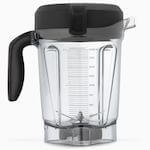 Vitamix released the “Next Generation,” aka “G-Series,” models in 2012. Both the base and the pitcher have an updated design. The base has slightly better sound muffling and also has better airflow which means that it can work harder before it overheats. To go with the better-cooled motor, the updated pitcher has a 4-inch blade instead of the Standard/Classic “C-Series” 3-inch blade. The 4-inch blade is in a shorter and wider container that has the same capacity as the 64-oz C-Series container.
Vitamix released the “Next Generation,” aka “G-Series,” models in 2012. Both the base and the pitcher have an updated design. The base has slightly better sound muffling and also has better airflow which means that it can work harder before it overheats. To go with the better-cooled motor, the updated pitcher has a 4-inch blade instead of the Standard/Classic “C-Series” 3-inch blade. The 4-inch blade is in a shorter and wider container that has the same capacity as the 64-oz C-Series container.
Advantages of the wider design:
• less need for the tamper (ingredients fall into the blades more easily)
• better chopping capability (you can course-chop more ingredients at a time)
• easier to scrape thick mixtures out
Advantage of shorter design:
• easier storage (at 17.5” tall, the container with lid on the base fits under standard kitchen cabinets)
Advantages of the 4-inch blade:
• faster processing time
• under some circumstances, marginally smoother blends
The one disadvantage of the new container is that for small volumes of under ~2 cups it does not work quite as well as the C-Series narrow container. The G-Series wider design causes two things to happen. First, there is more splashing up onto the inside of the lid and upper walls of the container, which means you lose a small amount of your blend unless you carefully scrape off the lid and walls. Second, you need slightly more volume to cover the blades and get good circulation going. The minimum volume to blend depends on what you are blending, and also on how much effort you are willing to spend pushing ingredients back into the blades. For example, for best results, the narrow containers can make nut butter easily by starting with 3 cups of nuts, whereas the wider Next Generation containers do best with 4 cups of nuts. For easier, more liquidy, blends, you can go below 1 cup in either container, but Next Generation containers will splash around more.
This disadvantage is a non-issue if most of your blends are over 2 cups, or if you are willing to spend a bit more to buy an additional narrow container, which will give you the best of both worlds. I like the 32-oz container for this purpose, although the 48-oz container has the same narrow bottom so it works just as well. The 48-oz container is just a bit bulkier on the outside because it sits outside the centering posts instead of inside of them, and its top is wider as well.
(The narrow C-Series Vitamix containers are compatible with G-Series models, but the G-Series containers are not recommended for use on C-Series models. The longer G-Series blades increase the load, and Vitamix does not recommend the C-Series cooling system for those increased loads.)
Reconditioned?
 Buying reconditioned is a great way to save money. For more details on deciding about buying reconditioned, see my refurbished Vitamix page.
Buying reconditioned is a great way to save money. For more details on deciding about buying reconditioned, see my refurbished Vitamix page.
Continue on for more details of each model type…
The array of different Vitamix blenders is a bit confusing, but it turns out that there is a lot of redundancy between the different models. I am only discussing models made for consumer/home use. Their commercial blenders are not ideal for home use because they are generally more expensive and have shorter warranties (3 years vs 7 years for home use; they are warrantied for constant use—think of how many times per day a blender at Jamba Juice runs compared to at your home).
The Vitamix website currently lists over 30 different home models, but they are all variants of three main designs: “personal” (S-Series), “standard/classic” (C-Series), and “next generation” (G-Series). For each of these main designs there are a few different options, to make a total of 8 different machine types. The rest of the models have identical bases, but come with different containers and/or accessories.
S-Series Motors
If the smaller size, dishwasher safe container, and “to-go” blending container appeal to you, please read the full details at my Vitamix S30, S50, and S55 review. For quick reference, the size of the base is 8.3″ deep x 5.9″ wide x 7.7″ tall. With the 20-oz to-go container the total height is 14.55″. The height is 15.66″ with the 40-oz container. These models have lower power, but they are still capable of making all of the usual Vitamix creations, just in smaller quantities.
C-Series Motors (Standard/Classic)
There are three types of bases of the standard variety. The differences are in the controls. The dimensions of the base of these machines are 8.75″ deep x 7.25″ wide x 8.25″ tall. There are three different container size options: 32 oz, 48 oz, and 64 oz, which result in height of base plus container/lid of 16.9″, 17.4″, and 20.5″ respectively.
Standard, no-variable speed (Vitamix TurboBlend Two Speed and Three Speed)
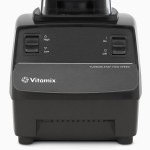 TurboBlend Two Speed (
TurboBlend Two Speed ($399$349); reconditioned for $299. This machine comes with a 5-year warranty and lacks the variable speed knob. Variable speed is useful for cases where you want to have finer control over the texture (i.e. if you don’t want a totally smooth purée). However, you can accomplish some non-liquefying chopping tasks by quickly pulsing the machine. While this is the most affordable new machine, I’d highly recommend looking at the reconditioned 5200, which has the same warranty and adds variable speed for $70 less.
In May 2016 Vitamix came out with a new no-variable speed machine, the TurboBlend Three Speed($499). It is exactly what it sounds like: it has three speed settings: low, medium, and high. It also has a pulse switch, which does the same thing as switching the start-stop button on and off. The pricing on this model is a bit strange, since for $50 less you can get a machine with fully variable speed. Plus, the TurboBlend 3-Speed comes with a 5-year warranty, instead of the 7 years on machines like the 5200.
Standard variable speed (Vitamix 5200 et al.)
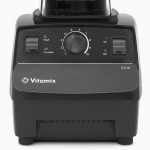 Until recently this was Vitamix’s bread and butter, and they have a lot of models to show for it: 5200 ($449), TurboBlend VS (retired), CIA Pro (retired), Pro 200 ($499), Creations II ($449), and Creations GC (retired); reconditioned for $329. These machines are essentially identical. Some are available with a shorter 48-oz container instead of the 64-oz container. The smaller container is nice because it’s more compact (and fits under standard kitchen cabinets), but of course its capacity is lower. The aesthetics of the switches and dial are slightly different between the different models. The Creations models come with a 5-year warranty, while the rest are 7 years. The 5200 comes with their “whole foods cookbook,” the TurboBlend VS comes with a vegetarian/vegan/raw cookbook and a nutmilk straining bag, the Pro models come with a cookbook with restaurant-oriented recipes (the CIA one—that’s Culinary Institute of America—comes with an additional recipe book). Note that if you buy reconditioned, you cannot choose which of the Standard models you are getting; Vitamix will choose for you based on availability, but remember that functionally they are identical.
Until recently this was Vitamix’s bread and butter, and they have a lot of models to show for it: 5200 ($449), TurboBlend VS (retired), CIA Pro (retired), Pro 200 ($499), Creations II ($449), and Creations GC (retired); reconditioned for $329. These machines are essentially identical. Some are available with a shorter 48-oz container instead of the 64-oz container. The smaller container is nice because it’s more compact (and fits under standard kitchen cabinets), but of course its capacity is lower. The aesthetics of the switches and dial are slightly different between the different models. The Creations models come with a 5-year warranty, while the rest are 7 years. The 5200 comes with their “whole foods cookbook,” the TurboBlend VS comes with a vegetarian/vegan/raw cookbook and a nutmilk straining bag, the Pro models come with a cookbook with restaurant-oriented recipes (the CIA one—that’s Culinary Institute of America—comes with an additional recipe book). Note that if you buy reconditioned, you cannot choose which of the Standard models you are getting; Vitamix will choose for you based on availability, but remember that functionally they are identical.
Sometimes these models are listed with their color-specific SKU. All of the following models are identical to the 5200, they just come with different colors and names: Vitamix 1709, 1363, 1364, 1365, 1709, 1723, 1732. They also sometimes go by VM0103. Vitamix 1978 is also the same, but comes with a 48-oz container.
Standard variable speed + presets (Vitamix 6300 and Professional Series 500)
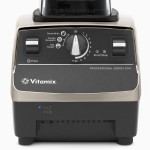 Pro 500 ($559) and 6300 (retired); reconditioned for $379. These are the same model; the only difference is that the 6300 comes with the “Savor” cookbook, which has a broader range of recipes than the Pro 500’s “Create” cookbook, which focuses more on restaurant-style recipes that tend to be richer.) They have 3 preset programs that run the blender for a certain amount of time and speed for smoothies, frozen desserts, and hot soups. Their switches are slightly different from the non-preset models. The non-preset models have an on-off switch, a variable speed knob, and a high-variable speed switch. The preset ones have moved the highest speed setting onto the knob and replaced the high-variable speed switch with a pulse switch. This is really a minor aesthetic difference, since you can achieve pulsing on the non-preset models by quickly flicking the on-off switch on and off.
Pro 500 ($559) and 6300 (retired); reconditioned for $379. These are the same model; the only difference is that the 6300 comes with the “Savor” cookbook, which has a broader range of recipes than the Pro 500’s “Create” cookbook, which focuses more on restaurant-style recipes that tend to be richer.) They have 3 preset programs that run the blender for a certain amount of time and speed for smoothies, frozen desserts, and hot soups. Their switches are slightly different from the non-preset models. The non-preset models have an on-off switch, a variable speed knob, and a high-variable speed switch. The preset ones have moved the highest speed setting onto the knob and replaced the high-variable speed switch with a pulse switch. This is really a minor aesthetic difference, since you can achieve pulsing on the non-preset models by quickly flicking the on-off switch on and off.
Some people love the presets because you can set it and walk away (assuming the mixture is circulating and you don’t need the tamper), and because they get more consistent results. However, the more consistent results will only hold if you always add the same quantities and types of items to the blender. For example, if you’re making a small smoothie, you can blend it for less time than if you were making a large one. One other thing is that you can set the non-preset machines and walk away—you just have to come back to stop them. I often use the blending time to rinse off the knife and cutting board that I used. You’re not likely to forget that the Vitamix is running because it’s loud enough to hear throughout the house. The variable speed knob goes to the same high speed as the previous models on high, but it’s lowest setting is a bit faster than on the 5200 et al., so you lose a tiny bit of fine control. Whether the presets are worth it is a personal question—I wouldn’t pay extra for them, but some people love them.
Standard no variable speed + presets (Vitamix 6000)
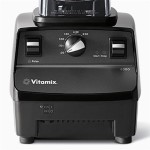 6000 (retired). Released October 2013, this is more of a mash-up of existing machines than a truly new one. It’s a sort of blend between the Two Speed, and the 6300. It does not have variable speed control, but it has six preset timed blending settings. These settings will automatically ramp up the speed, and then turn it off after a specified time of 20 sec, 30 sec, 1 min, 1.5 min, 4.5 min, or 6.5 min. Like the 6300, the pulse control is spring-loaded so that it only stays on as long as you hold it down, and it blends at a medium-low speed.
6000 (retired). Released October 2013, this is more of a mash-up of existing machines than a truly new one. It’s a sort of blend between the Two Speed, and the 6300. It does not have variable speed control, but it has six preset timed blending settings. These settings will automatically ramp up the speed, and then turn it off after a specified time of 20 sec, 30 sec, 1 min, 1.5 min, 4.5 min, or 6.5 min. Like the 6300, the pulse control is spring-loaded so that it only stays on as long as you hold it down, and it blends at a medium-low speed.
G-Series Motors (Next Generation)
In 2012 Vitamix released a new generation G-Series base with improved airflow that makes it run cooler and quieter than the classic C-Series one. With the improved cooling, the G-Series base can use a new pitcher design that is wider and has longer blades. This design makes the tamper less necessary, and makes it easier to get thick mixtures out. The longer blades also process food faster and work better for chopping. The G-Series machines are compatible with the C-Series containers, so if you want to use the dry blade you can use the same classic dry container. Dimensions are 9.4″ deep x 7.7″ wide x 17.5″ tall (with new-style 64-oz container in place). For more details of sizes, check out the PDF footprints I made for my Vitamix S30 review.
Next generation motor (Vitamix 7500, Professional Series 300, and Creations Elite)
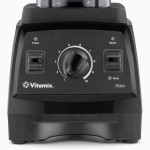 7500 ($529), Creations Elite ($557.50), and Pro 300 ($559); reconditioned for $439. These are all the same machine, so don’t worry about the note on the Reconditioned Next Gen page that says that the label may reflect any of these models. The only difference is the name printed on it. One point of confusion is that the Creations Elite is sold new with a smaller container, but if you happen to get sent a Creations Elite as a Reconditioned Next Gen, it will come with the same low profile 64-oz container that the 7500 comes with.
7500 ($529), Creations Elite ($557.50), and Pro 300 ($559); reconditioned for $439. These are all the same machine, so don’t worry about the note on the Reconditioned Next Gen page that says that the label may reflect any of these models. The only difference is the name printed on it. One point of confusion is that the Creations Elite is sold new with a smaller container, but if you happen to get sent a Creations Elite as a Reconditioned Next Gen, it will come with the same low profile 64-oz container that the 7500 comes with.
Next generation motor + presets (Vitamix Professional Series 750 and Vitamix 780)
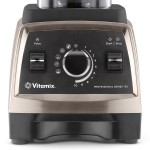
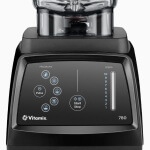 Pro 750 ($599–$649), 780 ($719); available reconditioned: 750 for
Pro 750 ($599–$649), 780 ($719); available reconditioned: 750 for $519–$569$499, and 780 for $519$399. These models have 5 presets: smoothies, frozen desserts, purées, hot soups, and self-washing. If you want to see more details of exactly what the presets do, check out my page about demystifying Vitamix presets. The 780 is identical, except that it has a touchpanel control interface. See my Vitamix 780 review for more details.
Vitamix Heritage 750 vs. Original 750?
In late 2015, Vitamix released a new version of the Pro 750: the Heritage line. The Vitamix Heritage 750 is functionally equivalent to the original Pro 750, but it has two differences on the exterior of the base. The upper shell (see diagram below) is now metal on the Heritage models. The Vitamix website doesn’t put Heritage in the model title, but it’s there in the description.
 The original 750 came in a brushed stainless finish option, but the upper shell was plastic with a thin metallic coat that could be scratched or scuffed. (When I tested the original 750 for a couple of months, I did not see any problems, but I have heard that some people have noticed scratches/scuffs.) The solid metal of the new Heritage models is more durable. Also, the metal shell muffles the the motor a bit more than the plastic, making the Heritage models a bit quieter.
The original 750 came in a brushed stainless finish option, but the upper shell was plastic with a thin metallic coat that could be scratched or scuffed. (When I tested the original 750 for a couple of months, I did not see any problems, but I have heard that some people have noticed scratches/scuffs.) The solid metal of the new Heritage models is more durable. Also, the metal shell muffles the the motor a bit more than the plastic, making the Heritage models a bit quieter.
 The other minor difference is that the Heritage models’ front panel has fewer backlights: Heritage models light up the indicators above the pulse and start-stop switches, whereas the original Pro 750 has backlights around the central knob as well.
The other minor difference is that the Heritage models’ front panel has fewer backlights: Heritage models light up the indicators above the pulse and start-stop switches, whereas the original Pro 750 has backlights around the central knob as well.
The Heritage metal is available in brushed stainless and copper finishes. (Currently on Vitamix.com, the Heritage options are listed on the main Pro 750 page, and the old brushed stainless finish is discontinued.)
I believe it is called Heritage because it is a throwback to the original Vitamix models that had all-metal bases. The plastic that Vitamix has been using for their bases for the past 25 years is extremely durable, so this change won’t affect functional longevity. That said, the elegant finish of the Heritage models will now likely stay unblemished for longer. It’s also nice that Vitamix did not increase the price for this upgrade.
The Vitamix 5300 and 6500
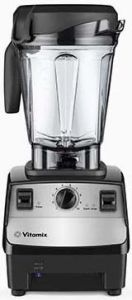 5300 ($529) and 6500 ($599); reconditioned for $360. Vitamix does not currently sell the new models online, only the reconditioned one. These are “new” models for 2015, although they are actually just slightly unexpected mash-ups of previous models. They are a hybrid between a 6300 and a 7500. They use the wide Next Gen (G-Series) container but they have a Classic (C-Series) base. The 5300 has variable speed and a pulse control switch, and has no presets. Meanwhile, the 6500 has the same three presets as the 6300. (Further evidence of equivalence between the 5300/6500 and C-Series models is on the Reconditioned C-Series 6300/Pro 500 page: it says its base may be a 6500.)
5300 ($529) and 6500 ($599); reconditioned for $360. Vitamix does not currently sell the new models online, only the reconditioned one. These are “new” models for 2015, although they are actually just slightly unexpected mash-ups of previous models. They are a hybrid between a 6300 and a 7500. They use the wide Next Gen (G-Series) container but they have a Classic (C-Series) base. The 5300 has variable speed and a pulse control switch, and has no presets. Meanwhile, the 6500 has the same three presets as the 6300. (Further evidence of equivalence between the 5300/6500 and C-Series models is on the Reconditioned C-Series 6300/Pro 500 page: it says its base may be a 6500.)
The reconditioned 5300 is the most affordable option for a machine with the short/wide container.
The strange thing about these models is that previously Vitamix stated that Next Gen containers should not be used on Classic bases because they do not have the updated airflow design that cools the motor more effectively.
I strongly suspect that the 5300 has the same microprocessor speed control as the 7500, Pro 750, and 6300, just without the presets. (You can read about the speed control of the different machines on my Vitamix RPM measurement page.) The microprocessor speed control should help protect the motor when using the wide container at high loads and very low speeds, but at maximum speed it shouldn’t make a difference. The marketing copy for the 5300 says that it comes “with a faster, yet quieter, motor,” but I am skeptical of those claims [Update: interestingly, Vitamix removed that phrase].
The 5300 and 6500 are a bit louder than the G-Series bases, which have sound-dampening technology not present in the C-Series bases. At the same price point, I would prefer the 7500.
Satisfaction Guarantee
Vitamix has a 30-day satisfaction guarantee, so if you have second thoughts you can return a machine within the first 30 days for a full refund and they even pay return shipping.
Warranty
If your machine has any problems during the warranty period of 5 or 7 years, Vitamix will repair or replace it, and they cover shipping costs both ways. For more details about warranties, check out my Vitamix Warranty page.
Reconditioned Vitamix
 I know I already mentioned reconditioned machines, but I want to restate what a great deal I think they are. These factory-refurbished machines offer the best prices you’ll find on Vitamix: 5200 for $329, Pro 500 for $379, and 7500 for $439. For more details, see my refurbished Vitamix page.
I know I already mentioned reconditioned machines, but I want to restate what a great deal I think they are. These factory-refurbished machines offer the best prices you’ll find on Vitamix: 5200 for $329, Pro 500 for $379, and 7500 for $439. For more details, see my refurbished Vitamix page.
Payment Plans
Want to start blending right away, but don’t want to pay the full price up front? Vitamix offers payment plans with zero interest and no fees if you make payments on time. For more information, check out my payment plan page.
Free Shipping
Clicking on any Vitamix link on this page will automatically apply a promotion code, which gives you free shipping on your order of a Vitamix machine (or anything else on Vitamix.com over $50) in the U.S. or Canada. For more details, see my page about the Vitamix promotion code.
Extra Bonus
If you order via a link on this site, Joy of Blending can get a commission. I deeply appreciate your support, and, to thank you, I want to help you get the most out of your new machine. I try to answer all questions from everyone, but sometimes I get swamped. If you order through one of my links, I will give you a private way to contact me so that I can answer your questions before visitors who are not on the special list. Please make sure my link is the last link you click before placing your Vitamix.com order. Then just forward your order confirmation to thanks@joyofblending.com.
Recommended Accessory
I highly recommend a spatula for getting the last bits of thick mixtures out of the container. For the narrow containers I recommend a long narrow spatula. For the wide containers, I recommend Vitamix’s under-blade scraper.
Dry Container
If you’re wondering if you should get a dry container, this new post is for you: Is the dry container worth it?
Phew… so that completes the Vitamix model round-up. I’m looking forward to getting back to describing some actual recipes!
Or follow along on Twitter or Facebook:

Hello, would you consider the Standard models, the 5200 and the 6300, to be the same except for the addition of preset options? Thanks for your help!
Yes, they are mostly same, other than the presets. The 6300 still has the full manual control found on the 5200. There are a few minor differences: the 6300 has a blue light on the front that lights up when it’s on, it has a secondary on-off switch, and the variable speed response is slightly different (see my speed measurement page for the nitty-gritty).
Thanks so much. Your website is packed with information and has been very helpful to me. Hopefully I can be a Vitamix owner soon!
My son and new daughter in law put the vitamix 1978 via professional series on their registry and when I look for comparisons I don’t find this one listed.is it similar to 750 ,better ,worse??
The “1978” refers to a specific color option. In this case, it is brushed stainless, and the model is a “CIA” w/ compact container, which is functionally identical to the 5200 w/ compact container. It is a fully capable model, but it is less fancy than the 750.
Hi, so can you actually use the newer squattier models of pitchers with the older machines that are only 2 HP and not 2.2 HP? Probably, right?
Vitamix “does not recommend it,” and they may say that it would void your warranty. But, yes the wide containers fit on the older machines.
The longer blades make the motor work harder, so they make it easier to overheat the motor. The new G-Series models have a different airflow design, which Vitamix says keeps the motor cooler. On the other hand, Vitamix started selling the 5300 and 6500, which use the classic base with the wide containers….
So, yes you can, just try to be a bit more careful about overheating. The main trick (which is slightly counterintuitive) is to set the speed to the maximum when blending thick things. A single overheating isn’t a big deal, but if you regularly overheat the motor, it will not last as long.
I’m confused on your post regarding the jar for the Next Geberation series, because on the vitamix website it states that the jar is a “low profile 64oz.”
What exactly is the confusion? That statement from the Vitamix website is correct, and, as far as I know, I say the same thing on this page.
What are the different Voltage and Watts. Does that make a difference on the strength of the machine?
The models on this page are for the US and Canada, so all of them are 120 V. Vitamix lists the wattage of the different series machines as follows:
S-Series: 790 W
C-Series: 1380 W
G-Series: 1440 W
Does wattage make a difference on the strength of the machines? Assuming you mean power output, the answer is yes.
The C and G-Series machines are significantly more powerful than the S-Series (although the S-Series is still surprisingly capable for its lower power — see my S-Series review for more on that.)
The difference in wattage between the C-Series and G-Series is not significant. For more information about power, check out my horsepower measurement page.
Hi,
I’m looking to buy a vitmaix blender. I don’t which to buy. I want anew model that’s good quality with two containers( a small & large one). What do you recommend?
I recommend the 7500 plus 32-oz container. Make sure you get your order in by July 31st to take advantage of the current container promotion, which will save you $79 on that container.
If you want preset modes, you could upgrade to the Pro 750, and if you want a touchscreen, you could further upgrade to the 780. I view the presets and touchscreen as unnecessary bells and whistles, but some people love them.
Hi! I’m looking to buy the Vitamix Reconditioned 5300 as well. But I’m curious why the brand new 5300 are not being sold online and a lot of factory reconditioned available? I’m thinking maybe there’s a lot of negative issues with the 5300’s that ended being returned by customers and eventually discontinued by Vitamix? Please advice…
The answer to both of your questions is: Costco.
Vitamix specifically rolled that model out for sale at Costco. So that’s why they don’t sell it online. And I believe the reason they have so many reconditioned ones is because the live demos attract a lot of impulse buys (some of those demonstrators are great salespeople!), which are more likely to result in returns. Reasons for return include a veto by a significant other, change of heart, or even because they do some research and realize that they can get the same performance for less by buying reconditioned.
Thanks a lot for all this great information Adam! This makes it even more easier to decide whether Vitamix is the right blender for my needs.
This is insane – akin to trying to price shop mattresses. Why does Vitamix make this so difficult with all of these different types/models/lines, etc? Seems like they do this on purpose for something in their favor!
They sell the models that are identical but have different names at different retail stores. I agree it is confusing, but I think it’s easier to figure out than mattresses. I hope the chart above makes it clear what the differences and similarities are.
Thanks Adam – very helpful review. In terms of the 7500 Heritage, I don’t see “Heritage” anywhere on the Vitamix website, even when I search that word – can you advise? Other retailers refer to Heritage though!
First, the Heritage distinction is currently only for the Pro 750 (not the 7500). On the Pro 750 page at Vitamix.com, the “Brushed Stainless Metal Finish” and the “Copper Metal Finish” are the Heritage Pro 750. Confusing that they don’t put Heritage there, I know, but those metal finish options for the Pro 750 are “Heritage”. The Reconditioned Pro 750s on Vitamix.com are not currently Heritage; it looks like Vitamix is subtly referencing that by calling the Recon Pro 750 stainless finish “Brushed Stainless” instead of “Brushed Stainless Metal Finish” on the new one.
Also – I don’t spend the money, but do you think the preset controls are worth it? Or do you end up just using the manual controls? I am considering the Pro 750 or the Pro 500. I wouldn’t be using this so often but want something powerful that will last a long time. Thanks!
I have a section above about whether presets are worth it. Short version: I don’t use presets, but I know some people who really like having them.
How does the VITAMIX Pro Series 200 Blender compare with the top of the line ones such as the latest 780, or Pro 750? Will it still do all the things the top of the line one does? ie: make soup, dough, flour, etc? THANKS!
Yes, the Pro 200 (which is equivalent to the 5200) can make everything that the Pro 750 and 780 can. Note that for dough and flour, you would ideally get a Dry Blade container, which you can use with any of those models.
what is the difference between a 32 oz dry container and a ‘regular’ 32 oz container? They look similar.
They are identical aside from the shape of the blade. The dry blade is designed to push ingredients up, to minimize packing of flour into the bottom corners, whereas the regular/wet blade is designed to pull ingredients down in a vortex.
i have a friend with a vitamix whose only suggestion for one different from hers is that it have a molded base, not one that screws apart for cleaning. i can’t tell from photos which ones are molded! please advise. thanks
I am assuming your friend is talking about the container. The S-Series “Personal Size” models use containers where the blade part unscrews from the jar, and you have to unscrew it to clean it. That was one of the only downsides that I found with those models in my S-Series Review. If you want to avoid that need to unscrew, all of the C- and G-Series models use containers that you do not unscrew to clean.
Great read and one of the best equipment comparisons I have seen.
Question: I don’t know which vitamix will work for my situation. Countertop storage is important to me for regular use. Because of the way our cabinets were refaced with LED lights hidden, I have only 17.25″ of clearance between the top of the counter and the bottom of the top cabinets. Cabinet has a small trim piece in front to hide the LEDs so the front height is 16″ straight in. As long as I can tilt the blender at an angle to slip it under the top cabinet, I have 17.25″ height.
I think the new Pro 780 would work, especially if I can get it with the 48 oz container. Given just 2 adults in our household, I’m not sure how often I would use the 64 oz container. I’d also likely get the 32 oz dry. I make a lot of smoothies, soups, dips, purée, and some stir fry. Eager to make frozen desserts too!
While I’m not that keen on fully electronic front controls, the size seems to work. If the Pro 750 (heritage) would work too, I’d likely go with it so I have full variable speed control.
I would value your opinion on what machine to get. Should I consider some blender other than the vitamix for my situation?
I think a full-size Vitamix (i.e. not a “personal size” S-Series) plus container, lid, and lid plug will only fit under your cabinets with a 32-oz container. I think the 48-oz container would fit if you take off the lid plug. Both would require some tilting to get under the lip. There are also some tricks you can play with inverting the container and/or lid to make it a little shorter, or you can just keep the container next to the base. Or you can get a tamper holder, and hang the lid on the tamper.
If you’re not keen on fully electronic controls, don’t get the 780. The Pro 750 is the same as the 780, except it has switches and a knob, so it would be a better choice. And I do think a Vitamix is the way to go. (Unless the shorter height is really important to you, in which case Blendtec models are under 16″. But all of their models have fully electronic control through buttons and/or touch interface.)
Adam, thank you for the terrific suggestions and quick response. I will look at these options at a retail store so I get a better sense of the footprint, etc. I do have room on my counter next to the cabinet without storing UNDER the cabinet if tilting/lid adjustment doesn’t seem practical.
Do you think the 32oz is too limiting? I’m hoping to use my food processor less and sometimes I find the standard size food processor bowl a little too small, especially for leafy greens and liquids. I’m leaning towards the 48 oz or 64 oz. and understand the trade-offs.
I currently use a stick blender and very happy to get the Vitamix soon!
Again, thanks!
Sarah
I do think the 32-oz container only would be a bit limiting. But since you can’t get a machine with only the 32-oz container, people with the 32-oz container almost always also have a 64-oz container. That way you can pull out the 64-oz container when you want to blend a big batch. The 48-oz container is a good choice if you want to use just one container (assuming 48 to ~55 oz is enough capacity for you).
Since you mentioned footprints, you might be interested in a printable PDF I made that shows how much lateral space the different series models take up (make sure it prints at 100%, and not “fit to page”).
Adam – just tried to make pesto using the Professional Series 750 model with the included 64 oz container. The problem was that we did not make a big batch of it and the blender barely worked. We tried to blend and then a second later the ingredients were on the side of the container so the blade had nothing to blend. Then we would stir it back together so the ingredients touched the blade, blend for 1 second, and repeat! Ridiculous I know. What would solve this – a 32 oz container? I am concerned that the same problem would exist because that smaller container is wide too, or am I wrong? Can you let me know the exact smaller container I should buy? Thanks!
Yeah, that is the one downside to that model/container. I mention it on this page in the C-Series vs. G-Series section. A 32-oz container will let you blend a smaller amount than the wide 64-oz G-Series container. If you try to make too small of a batch in the 32-oz container can have the same problem that you ran into. I make pesto with 2 cups of basil and 1/2 cup of olive oil in the 32-oz container. For pesto, you want the “wet blade” 32-oz container.
Also, you say to buy an extra 32 oz container to use for smaller batches. I see that it has a 3 inch blade. Does my Pro 750 have a 4 inch blade? So I assume using the 32 oz with smaller (3 inch) blade makes it easier to blend smaller batches, like the problem I had in my previous post? Thanks.
Yes, that’s right. I guess you posted this while I was composing my earlier reply, and I didn’t see it until just now.
Do dry blades/containers every go on sale? Can you find them for less than $144?
Vitamix sometimes runs promotions on them, but usually the promotion requires buying a machine as well. The best price I’ve seen consistently is on Amazon, for closer to $100 (their prices constantly fluctuate, so follow the link to check current pricing).
Thanks Adam, just ordered the 32 oz container through your link!
Hey, I had a couple questions for you Adam if you could help me out.
I have a Red Professional Series with the model number VM0103 (11.5 watt) and need another container. I am thinking tjis might be a bit older as I am not seeing anything like a C or a G Series, etc. Do you know if all the containers are interchangeable and do you have a recommendation for which one to get?
Also the base is missing one of those black rubber plugs it rests on, do you know where I can find one of those?
Thank you in advance,
Glen
That is a C-Series model (C for “Classic). So you can use the 32, 48, or 64-oz containers with it—basically any container except for the smaller S-Series containers.
Here’s a link to replacement rubber feet. (I assume that’s what you’re referring to, and not the rubber centering pad that the container sits on.)
Hello, I just bought the 6500 model because it has the presets and still has the 2.2 motor but the classic style base. But now I’m wondering if I should trade it for the 7500 model? Will the air flow in 6500 be an issue? Is the 7500 quieter even though they both have 2.2 hp motors?
The airflow design of the 7500 is indeed different from that of the 6500. Vitamix says it keeps the motor cooler, which should prolong the life of the motor. The design of the base of the 7500 also uses more sound-proofing. The difference in sound is not too major though. I prefer the 7500 for these reasons (plus the sleeker styling), but the differences are not that large.